Department of Homeland Security COVID-19 Contract Spending Analysis
Published: May 28, 2020
Federal Market AnalysisContracting TrendsCoronavirus (COVID-19) PandemicDHSSpending Trends
The Department of Homeland Security has spent more than $1.8 billion to date for COVID-19 response requirements.
Key Takeaways
- The Department of Homeland Security has spent more than $1.8 billion to date for COVID-19 response requirements.
- More than $1.7 billion, or 95%, of DHS contract spending so far has run through FEMA, with ICE being the next closest component at $51 million, or about 3% of the total.
- Over 85% of DHS contract spending to date has been focused on Architecture Engineering and Construction; Medical and Scientific Equipment; and Health Services. Information Technology accounts for 1.3% of their COVID-19 contract spending so far.
- Contract data shows a spike in COVID-19 related contract awards in April, with a significant tapering-off in May, although additional data may trickle in. It is too soon to know whether there may be subsequent growth or whether the majority of DHS’s pandemic response contracting has already occurred.
Homeland Security COVID-19 Contract Spending
Several weeks have passed since I last looked at how the Department of Homeland Security (DHS) is awarding federal contracts in support of their broad coronavirus response efforts and requirements. Contracted coronavirus response activities using the CARES Act and other stimulus funds are required to be flagged under the COVID-19 National Interest Action (NIA) in the Federal Procurement Data System.
To date, DHS has obligated more than $1.8 billion over the last three months, although we still have a few days left in May in which contracts may be awarded. The vast majority of the spending has come in April, with May slowing down considerably. (See chart below.)
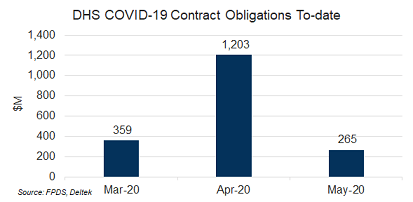
With all but $400 million of the total $45.8 billion in DHS CARES Act funding going to the Federal Emergency Management Agency (FEMA) for its lead role in the federal COVID-19 response, FEMA continues to dominate DHS COVID-19 spending, accounting for just under 95% of contracted dollars to date. Immigration and Customs Enforcement (ICE) has issued nearly all of its contracts in the last few weeks, making it now the second largest spending DHS component ahead of the Management Directorate and the US Coast Guard (which had been in second place through April with $14 million in awards then.) (See chart below.)

The Primary Requirement for which DHS has been seeking – the main type(s) of products and/or services being procured – remain fairly consistent. The spending data shows that DHS has been focusing their COVID-19 contact spending to date on the areas of Architecture Engineering and Construction; Medical and Scientific Equipment; and Health Services – together accounting for nearly 87% of DHS contract spending so far. Another 5.4% was spent on Machinery, Equipment & Tools with the remaining 8% of contract dollars spread among Professional Services; Food and Sanitary Products and Services; Information Technology and all others. Professional Services has grown from $14 million to more than $67 million during May. (See chart below.)
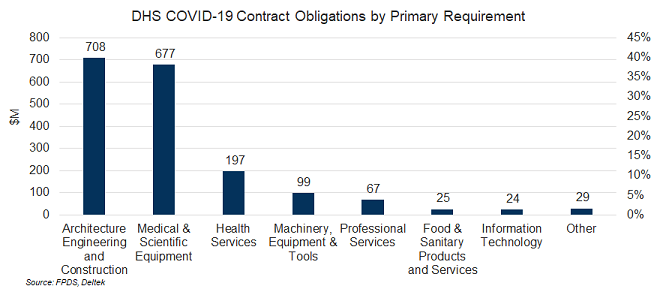
Delving into the most frequently used Product Service Codes (PSC) reported for DHS contract obligations so far shows that the data aligns fairly well to the Primary Requirement areas. The top five PSCs carrying the largest portion of obligations – nearly $1.4 billion of the $1.8 billion to date – account for nearly 75% of total obligations. The next five account for another $324 million and 18%, resulting in the top ten PSCs covering 92% of DHS’s obligations so far. (See chart below.)
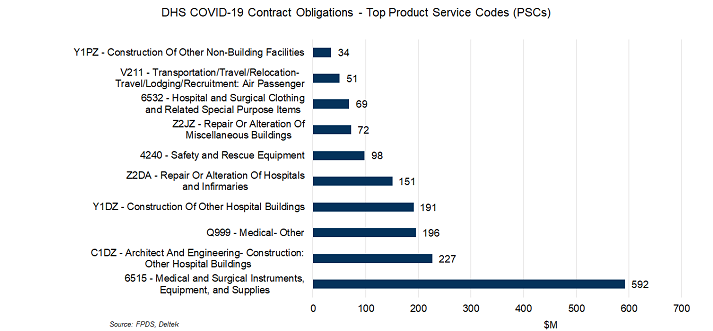
Similar to how the kinds of services and goods that have been procured to date are fairly concentrated, $1.1 billion of the $1.8 billion in contract dollars have gone to ten companies, although no one company dominates among them. These top ten firms account for more than 60% of DHS COVID-19 contract spending to date. The top four firms account for $751 million and each average about 10% of the total $1.8 billion in awards. The next six account for $390 million and each average 3-4% of the total awards. The remaining 100+ firms that make up All Others account for $687 million (38%) of the obligations to date. (See chart below.)
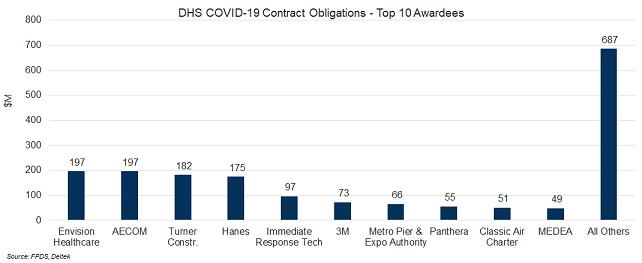
Where Preference Programs and set-asides to small businesses are concerned, DHS has awarded more than 95% of their contract dollars to date without using any set-aside programs. Of the total $1.8 billion in contracts awarded so far only $82.7 million (4.5%) has gone to companies using some form of set-aside program. Yet, through April that rate was less than 1.5%, so some positive movement has occurred. Small Business Set Aside – Total grew to over $71 million from $7.8 million over the month of May. Still, the amount of contract obligations that fall under No Set Aside Used dominates the award and has grown to over $1.7 billion, up roughly $230 million in May. (See chart below.)

The Place of Performance where DHS has been spending its COVID-19-related dollars is also fairly well concentrated. The top five jurisdictions – New York State, the District of Columbia, Illinois, Tennessee and New Jersey – account for nearly 70% of contact dollars to date. The N/A-Undetermined or unspecified category accounts for another 7% of obligations and the remaining states account for 25% of contract obligations. (See chart below.)
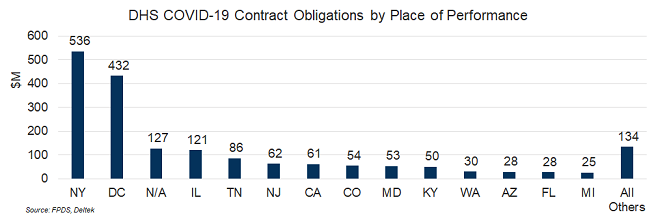
Even with the apparent slowdown in the amount of DHS COVID-19 federal spending that the contract obligation data seems to suggest, it is difficult to conclude that the trend will continue downward. As DHS and its component agencies continue their respective COVID-19 response efforts and also look forward to how they will operate over the coming months as some
Efforts to sustain an ongoing pandemic response – as well as sustain remote and other adjusted operations – will require industry support to meet the varied demands. Whether these contracts will continue to be awarded under the COVID-19 National Interest Action code is yet to be seen, but we will continue to watch for such trends.